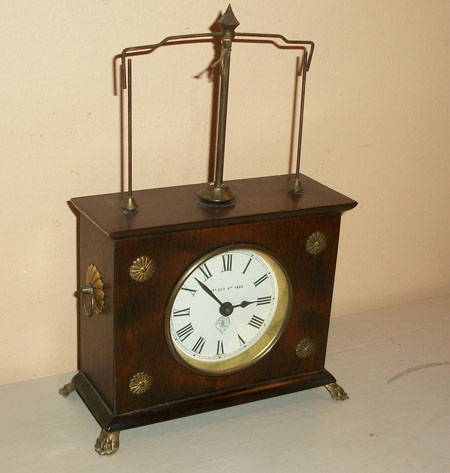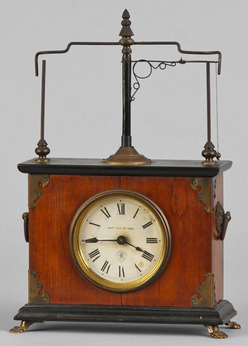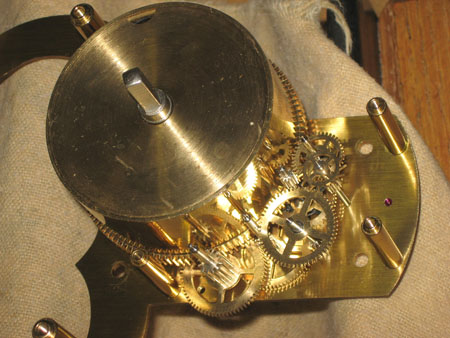The Ignatz Clock, or the Mystery of the Flying Pendulum

I ran across something on the top of the files in Mom’s excellent library in the Little House on the bluff above the Bay. It was part of the flotsam and jetsam of a long life, and an active and playful family. This was a story from Uncle Jim. It was contained on a couple yellowed pages bound together with a little curious fold of paper, produced by a triangular paper tongue punched with some antique tool. I could tell it was one of Uncle Jim’s informative letters- or what he would have known as a letter, back when typewriters were typewriters, and Xerox machines were still wonders of technology.
He could not have imagined YouTube, I don’t think, but who knows. He was a visionary, and this probably would have fascinated him and prompted another story: http://www.youtube.com/watch?v=qRK0N4AHs4s
Uncle Jim was a master storyteller, and he interpreted technology from an engineer’s perspective. In this telling, “Dad” is our Grandfather, JB, the Western Electric telephone pioneer. I read the words and remembered:
“According to horology buffs,” he started, “the Flying Pendulum mechanism appeared somewhere around Minneapolis in about 1885. It picked up the name “IGNATZ, “ a name later associated with a cartoon cat figure. A rather demented cat.*” It goes and flows from there. I loved his stories, and here is one for you this morning:
“The Flying Pendulum Patent was issued to Adler Clausen of Minneapolis, 09 October 1883. The original clocks were manufactured in 1884 and 1885 only.
At no time could such a clock ever be claimed to be a good timekeeper. Rare specimens, rigorously refurbished, may exhibit departure from correct time amounting to many minutes per hour in erratic fashion. Apparently shopkeepers displayed the because of customer fascination with the mechanism.
In about 1964, an American clock buff arranged to have a facsimile clock produced in Germany which he called the “HOROLOVAR,” and enough were sold to collectors to justify his investment. It was argued that every psychiatrist’s office should have one. It’s weird operation could sooth the most agitated patient, or, failing that, create new business!
I judge that Dad must have seen one somewhere. We never discussed his inspiration to utilize flying pendulum mechanism. His appreciation was to slow down an output power shaft from a coiled spring driver in a simple and cheap manner, where precise regulation of shaft speed was not critical. He had no means ot construct a gear train speed reducer in the classic pattern, and here was a device of simple construction that would meet his requirements.
The specimen of his handiwork that you have (Note: a refurbished model is on the shelf in the library in the house on the bluff above the Bay) operates a simple switch. Dad built this from junk parts salvaged from some spring-driven Western Electric telephone device. It switched between two strings of telephone switchboard lamps that he strung in our earliest Christmas trees, at 20 North 19th Street in East Orange NJ.
Our home had no electricity; lighting was by gas mantles. For Christmas, Dad would rent an automobile storage lead-acid battery to light these Christmas tree lights. And run the railroad trains! Such batteries (6-volt) were not built with today’s quality. Acid leaks are holes in the carpet and stained the parlor flooring behind the Christmas tree, which created some problems with the Landlord. ($20/month rent!). Within days, Dad would have to lug the battery back to the garage for re-charging and the acid holes in his suit brought him some problems from another quarter!
His other device using the flying pendulum regulation was quite similar in construction made from many of the same parts. It was a device for learning Morse Code. Such mechanisms were available in he market, but beyond his price. Code “messages” were toothed patterns cut into aluminum discs about three inches in diameter. Dad somewhere acquired a couple of dozen of commercially-produced discs, which he could fit to his spring-driven mechanism. The toothed discs opened and closed a switch in a battery-powered buzzer circuit by which the student learned to read the Morse Code. Dad’s disc wheels were all in Morse Code, no International Code. Dad never learned the Code. Neither did I!
This device, and discs, is currently in the possession of the Antique Wireless Association Museum in Holcomb, NY, 30 miles south of Rochester.
Dad constructed a second mechanism but without using the flying pendulum regulator. It had a fly ball governor braking mechanism very similar to the speed-control device found in current telephone rotary dials. Speed could be varied over a narrow range. I do not know what became of it; it was nowhere near as fascinating to watch as the flying pendulum mechanism.

(Model 1964)
Here’s the gadget clock most sought after by collectors and lovers of things different. Often called “Ignatz- The Craziest Clock in the World!” the clock unfailingly draws crowds wherever it is displayed. The reason: it unusual, “top-of-the-clock” tether ball escapement action fascinates all who see it. The Horolovar Flying Pendulum clock is a reproduction of the American original on sale in 1885. The clock provides an attention-getting display for counter, window or home. As a gift for a friend, with imagination it is unsurpassed. (The 1964 mode3l has 11 improvements over the 1961 model, none of which relates to is timekeeping. Each clock is carefully pre-packaged in a sturdy crush-proof carton. Two booklets are included: one, instruction on how to live with Ignatz; the other, a history of the clock and the story of its inventor.
$27.50 Postpaid


“In the above clocks, the center spindle was rotated from a spring motor; it has a rigid horizontal arm from whose end dangled a light, flexible chain with a weight on the end. As the arm rotated, picking up speed, the weight flew outward snagging itself at each half-turn, on one of a pair of rigid needles atop the clock case. The chain wrapped itself around the obstructing needle, came to rest, unwound itself from the needle, and started around the next half-turn to the second needle obstruction, etc.”

* Note: Uncle Jim was rarely wrong, but he is here. Ignatz was the brick-throwing mouse in the American comic strip Krazy Kat created by cartoonist George and published daily in newspapers between 1913 and 1944. It first appeared in the The New York Evening Journal, whose owner William Randolph Hearst was a major booster for the strip throughout its run. The strip focused on the curious love triangle between its title character, a guileless, carefree, simple-minded cat of indeterminate gender (referred to as both “he” and “she”); the obsessive antagonist Ignatz Mouse; and the protective police dog, Offissa Bull Pupp. Krazy nurses an unrequited love for the mouse. However, Ignatz despises Krazy and constantly schemes to throw bricks at Krazy’s head, which Krazy misinterprets as a sign of affection, uttering grateful replies such as “Li’l dollink, allus f’etful.”Offissa Pupp, as administrator of law and order, makes it his unwavering mission to interfere with Ignatz’s brick-tossing plans and lock the mouse in the county jail. The reference to the clock as “Ignatz” may refer to the popular descriptive term “Crazy as waltzing mice.”
Copyright 2012 Vic Socotra
www.vicsocotra.com
